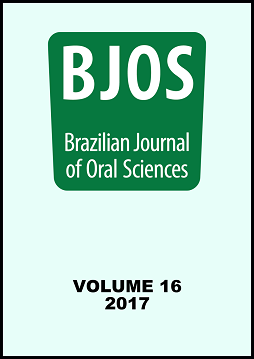Abstract
Aim: The aim of this study was to evaluate the presence of filling material in oval root canals after endodontic retreatment performed by different techniques, considering the area (mm2), location and root third using computed microtomography (µ-CT). Methods: Thirty human lower central incisor underwent biomechanical preparation, root filling and filling removal using two techniques (n=15): MN- manual retreatment technique (Gates Glidden burs and stainless steel manual files); and RT- rotary retreatment technique (ProTaper Universal and ProTaper Retreatment Systems). Cross-sectional images of the teeth were made using µ-CT to identify the presence of remaining filling in all root thirds of the canal walls. The remaining material detected in 150 µ-CT sections was identified and its area quantified (mm2) for each root third individually. Results: Data analysis showed no difference in the remaining area of filling material (p=0.8611) for the both techniques. Higher frequency of remaining material was verified in the lingual wall of the root canals. Regardless of the retreatment technique, the apical third showed lager areas of remaining filling material. More areas of remaining material were detected in the cervical third of the RT group, whereas for the MN group, most areas were observed in the middle and apical thirds. Conclusion: According to our results, no significant differences were verified between the efficiency of the rotary and manual techniques for removing filling material due to the interferences caused by the root canal anatomy.References
Iriboz E, Sazak Öveçoğlu H. Comparison of ProTaper and Mtwo retreatment systems in the removal of resin-based root canal obturation materials during retreatment. Aust Endod J. 2014 Apr;40(1):6-11. doi: 10.1111/aej.12011.
Joseph M, Ahlawat J, Malhotra A, Murali-Rao H, Sharma A, Talwar S. In vitro evaluation of efficacy of different rotary instrument systems for gutta percha removal during root anal retreatment. J Clin Exp Dent. 2016 Oct 1;8(4):e355-e360.
Crozeta BM, Silva-Sousa YT, Leoni GB, Mazzi-Chaves JF, Fantinato T, Baratto-Filho F, et al. Micro-Computed Tomography Study of Filling Material Removal from Oval-shaped Canals by Using Rotary, Reciprocating, and Adaptive Motion Systems. J Endod. 2016;42(5):793-797.
Ersev H, Yilmaz B, Dinçol ME, Dağlaroğlu R. The efficacy of ProTaper Universal rotary retreatment instrumentation to remove single gutta-percha cones cemented with several endodontic sealers. Int Endod J. 2016 May;42(5):793-7. doi: 10.1016/j.joen.2016.02.005.
Rossi-Fedele G, Ahmed HM. Assessment of Root Canal Filling Removal Effectiveness Using Micro-computed Tomography: A Systematic Review. J Endod. 2017 Apr;43(4):520-526. doi: 10.1016/j.joen.2016.12.008.
Fariniuk LF, Wesphalen VPD, Silva-Neto UX, Carneiro E, Filho FB, Fidel SR, et al. Eficacy of five rotary systems versus manual instrumentation during endodontic retreatment. Braz Dent J. 2011;22(4):294-8.
Khalilak Z, Vatanpour M, Dadresanfar B, Moshkelgosha P, Nourbakhsh H. In vitro comparison of gutta-percha removal with H-File and ProTaper with or without Chloroform. Iran Endod J. 2013 Winter;8(1):6-9
Vale MS, Moreno Mdos S, Silva PMF, Botelho TCF. Endodontic filling removal procedure: an ex vivo comparative study between two rotary techniques. Braz Oral Res. 2013 Nov-Dec;27(6):478-83. doi: 10.1590/S1806-83242013000600006.
Simsek N, Keles A, Ahmetoglu F, Ocak MS, Yologlu S. Comparision of different retreatment techniques and root canal sealers: a scanning electron microscopic study. Braz Oral Res. 2014;28. pii: S1806-83242014000100221.
Silva EJNL, Orlowsky NB, Herrera DR, Machado R, Krebs RL, Coutinho-Filho, TS. Effectiveness of rotator and reciprocating movements in root canal filling material removal. Braz Oral Res. 2015;29:1-6.
Crozeta BM, Silva-Sousa YTC, Leoni GB, Mazzi-Chaves JF, Fantinato T, Baratto-Filho F, et al. Micro computed tomographic study of filling material removal from oval-shaped canals by using rotary, reciprocating, and adaptive motion systems. J Endod. 2016 May;42(5):793-7. doi: 10.1016/j.joen.2016.02.005
Özyürek T, Demiryürek EO. Efficacy of different nickel-titanium instruments in removing gutta-percha during root canal retreatment. J Endod. 2016 Apr;42(4):646-9. doi: 10.1016/j.joen.2016.01.007.
de Siqueira Zuolo A, Zuolo ML, da Silveira Bueno CE, Chu R, Cunha RS. Evaluation of the Efficacy of TRUShape and Reciproc File Systems in the Removal of Root Filling Material: An Ex Vivo Micro-Computed Tomography Study. J Endod. 2016 Feb;42(2):315-9. doi: 10.1016/j.joen.2015.11.005.
Bussab WO, Morettin PA. [Basic Statistics]. 5th ed. São Paulo: Saraiva; 2006. p 526. Portuguese.
Oliveira MAV, Venâncio JF, Pereira AG, Raposo LHA, Biffi JCG. Critical instrumentation area: influence of root canal anatomy on the endodontic preparation. Braz Dent J. 2014;25(3):232-6.
Crăciunescu EL, Boariu M, IoniŢă C, Pop DM, Sinescu C, Romînu M, et al. Micro-CT and optical microscopy imagistic investigations of root canal morphology. Rom J Morphol Embryol. 2016;57(3):1069-1073.
Duarte MAH, Só MVR, Cimadon VB, Zucatto C, Vier-Pelisser FV, Kuga FV. Effectiveness of rotary or manual techniques for removing a 6-year-old filling material. Braz Dent J. 2010;21(2):148-52.
Oliveira MAV, Alves LD, Pereira LHA, Biffi JCG. Influence of flexion angle of files on the decentralization of oval canals during instrumentation. Braz Oral Res. 2015;29. pii: S1806-83242015000100273. doi: 10.1590/1807-3107BOR-2015.vol29.0078.
Topçuoğlu HS, Düzgün S, Kesim B, Tuncay O. Incidence of apical crack initiation and propagation during the removal of root canal filling material with ProTaper and Mtwo rotary nickel-titanium retreatment instruments and hand files. J Endod. 2014 Jul;40(7):1009-12. doi: 10.1016/j.joen.2013.12.020.
Grischke J, Müller-Heine A, Hülsmann M. The effect of four different irrigation systems in the removal of a root canal sealer. Clin Oral Investig. 2014 Sep;18(7):1845-51. doi: 10.1007/s00784-013-1161-6.
Souza MA, Motter FT, Fontana TP, Ribeiro MB, Miyagaki DC, Cecchin D. Influence of ultrasonic activation in association with different final irrigants on intracanal smear layer removal. Braz J Oral Sci. 2016 Jan-Mar;15(1):16-20.
The Brazilian Journal of Oral Sciences uses the Creative Commons license (CC), thus preserving the integrity of the articles in an open access environment.


